
|   |

|   |
Samvatsar Katha - Tapati Chowdhurie e-mail: tapatichow@yahoo.co.in Photos courtesy: Piyal Bhattacharya July 9, 2022 Founder Director of Chidakash Kalalaya, Kalamandalam Piyal Bhattacharya is a Sanskrit scholar well versed in music and drama besides of course dance. He has been researching and practicing Bharata's Natyasastra and all other connected ancient texts for the presentation and reconstruction of Rupakas, which are Rasatmaka and Uparupakas which are Bhavatmaka. Piyal Bhattacharya has named this reconstructed form Marga Nritya and has opened up new vistas in the field of classical theatre, drama, and dance dramas. He is engaged in finding the hidden treasures of the Natyasastra about music, dance and drama. In his intense search for the kind of music mentioned in the Natyasastra he has left no stone unturned. He has learned from classical musicians, both in India and abroad, recreating instruments as mentioned in the Natyasastra, like the veena and the harp. He has taken his audience through his arduous journey enriching them in turn. 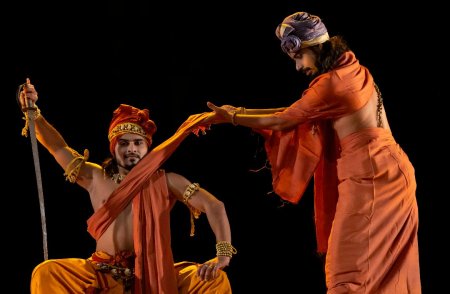 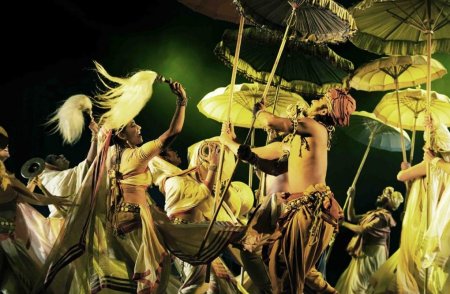 Retaining the classical core as per Natyasastra is no cakewalk. Recently Sanskriti Sagara presented Piyal Bhattacharya's Samvatsar Katha which was a reconstruction of a mode of performance named Ramakrida. This presentation enumerated Nature's play with the seasons. Nature and seasons have been personified. 'Rama' means nature (Prakriti) and 'Krida' is the play. Nature or Prakriti is the Nayika who is dressed in many hued garbs to suit her Nayaks, the Ritus or seasons, who are as different from each other as chalk and cheese. Prakriti changes herself throughout the year as she plays the passion plays with the seasons. Prakriti is a conforming as well as a scintillating Nayika. Her relationship with every season is as if she knows no other who could be more romantic. Prakriti is a conformist as far as Grishma's tormenting is concerned. A heated consort who sucks the sap out of her and offers dreary dryness in return, whereas Varsha is the giver - one who resurrects life and bejewels her with fresh green ornaments. Sharad brings a state of balance to give Prakriti a mellowness. Shishir brings a momentary stagnancy. But that is only a phase of hibernation before the arrival of her most awaited lover who is none other than the king of the Ritus - Vasant. Thus, Samvatsar Katha brings you the cosmic coition and divine daintiness of Prakriti and Ritu. Samvatsar Katha was the reconstruction of Uparupaka Ramakrida. Ramakrida is to be found in the works of Acharya Abhinavagupta, where he has also mentioned the names of nine Uparupakas. After this, he has recounted an account from his earlier master Chirantan - "Ritubananasayuktam Ramakrida thubhashyate", which means that the description pertaining to seasonal manifestation is known as Ramakrida. He has also mentioned two Uparupakas before and after this Ramakrida, which seemed kind of complementary to the conceptualization of this particular Uparupaka. It is actually an enigmatic, yet humorous representation strung with riddles where the dance presentation is performed in circular formation and is known as Hallisaka. In coherence to Piyal's vision of Ramakrida, while elucidating the core worldview and its subsequent unfolding through various dramatizations of selective texts, Piyal did the anukirtana - proclaiming or narrating - from Natyasastra of Bharata Muni with the commentary Abhinavabharati by Abhinavagupta about all the three instructions pertaining to Prerana, Ramakrida and Hallisaka in order to reconstruct his envisioned manifestation of Samvatsar Katha. Reconstruction of Ramakrida is an exploration of the poetic liberations granted by the Sastrakartas, regarding the Uparupakas. Since the coming into existence of this universe till this date is Prana, which has been ever pulsating, the birth of Prana has no pause or end. The stream of Prana flows from the beginning till the end of the universe with five of its activities - Vedana, Kampana, Prakasha, Vidravana, and Nidhana. The confluence of the astral and gross world with Prana generates a sense of subjectivity (Visaya) within the universal mind (Buddhi). This is realized as Vedana. Practical reconstruction of this particular Uparupaka Ramakrida draws its chromatic and semantic influence from Ragamala paintings of late 16th to early 18th century from different regions like Rajasthan, Deccan, and Nepal. The texture and expression of these paintings convey the luxury and opulence of that region and uphold the social imagery. The attires and ornaments of their presentation were heavily influenced by such paintings, which specifically transports us to the dramatized reconstruction of the medieval Indian era. The main textual impetus arrived from Kalidasa's Ritusamhara, Magh's Sishupalavadha's sixth canto, and Jaiminiya Upanishad. This literature was mainly limited to scholarly practices but this reconstruction of Uparupaka Ramakrida Samvatsar Katha demanded lucidity and a core worldview to form the content of this presentation. 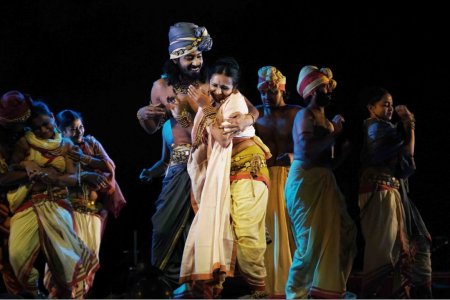 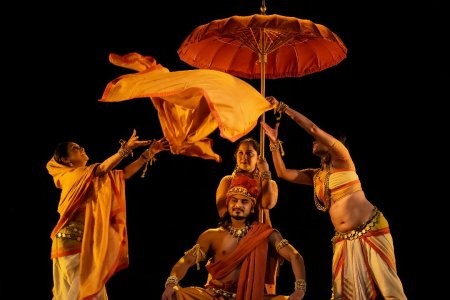 An in-depth study of Satapatha Brahmana Vijnanabhasya by Pt. Madhusudan Ojha and Pt. Motilal Shastri at Shree Shankar Shikshayatan, New Delhi, has provided an enriching core worldview. Music is also an integral part of this reconstruction as musical preferences have gradually changed with time. Dhrupad songs were structured under specific ragas, which were devised to provide the imagery of Ritus. Such ragas bound this dramatic presentation with one thread. The 'Padas' or the literature of those songs provided the pictorial description of the seasonal changes that Nature paints. Raga Megha and the use of percussions, mainly shrikhol represented the elephantine nature of a cloudy monsoon sky (Varsha), an inspiration from Kalidasa's Ritusamhara (Ashani). The instruments used here are a combination of ancient and medieval instruments, which sets the tone of this reconstruction. Ragas formed the fabric of this reconstruction as it inspired the visual imageries of this production. The perfect symphony of summer heat in the morning and its breezy evenings are suggested by the use of Brindavani Sarang to illustrate Grishma (Summer). Sharad arrived with the selection of Devi Sukta and shlokas from the 2nd canto of Bhaktikavya. The arrival of Varsha is with a procession enactment of the shlokas. Hemanta (Fall) is the transitional Ritu, a harbinger of winter, which is depicted by raga Bihag suggestive of the depressive feeling of the estranged lovers. Raga Vasanta heralds the onset of Vasanta (Spring) that enchants nature and intoxicates it with lust and merriment. Hemanta is wrapping each and every living being with a bleak cover. The subtlety of the first sensational disposition is elucidated through the arrival of each Ritu as the masculine entity wrapped in royal grandeur and Nature's delightful desire to succumb to its enigma. Grishma is the Ritu of heat and exhaustion which has the vigorous energy to absorb and leaves Nature bare and parched. The proximity with the Ritu arouses the senses and brings in the cognitive association with indulgence, thus, the first exposure to an external sense. Example: Varsha (Monsoon) first gives you an external sense of vedana or sadness. 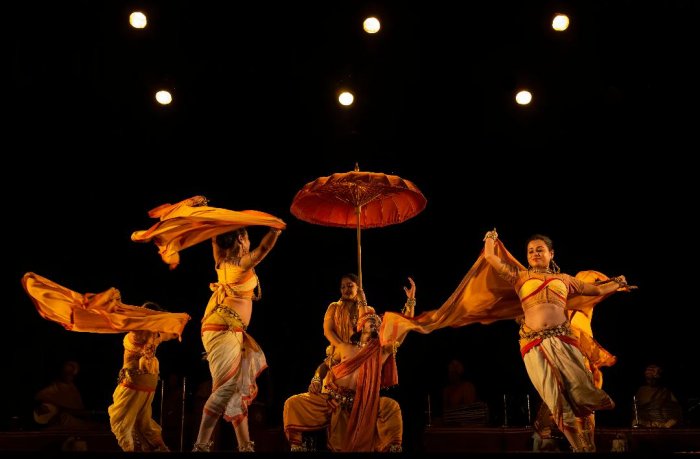 Piyal Bhattacharya has imaginatively selected lyrics to suit the different seasons. Suitable dramatization of summer was made possible with "Dahana lage Suraja kirana"; similarly, for Varsha he had selected "Prabala dala..." written by Tansen; for Vasanta, Piyal chose a Dhamar "Savare ranga dar diyo ...." followed by "Lalita lavanga lata." Samvatsar Katha being a sort of Uparupaka which came much later than the Natyasastra period, this production falls under Uparupaka Ramakrida. This production is basically not based on dance alone. Rather it is an amalgamation of dance, music, vachik put together. It, therefore, falls under the category of natya. As he has always done in all his previous productions, Piyal Bhattacharya followed all the eleven Natya Sangraha, which are the major elements of Indian natya as mentioned in detail by Bharata in chapter 6, sloka number 10 of Natyasastra. The dance style of the piece was based on Natyashastrik Chari, Karana, Sthanaka, and Gatibheda. At the outset of Ramakrida, Sayak Mitra entered with his face covered with a veil soon to be taken off to symbolically represent the creation from its unmanifested state to that of the manifested. 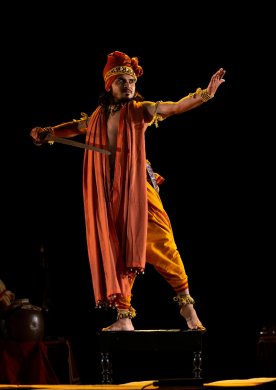 One unique aspect of the production was the costumes. The entire team of male and female actors of the production took part in dyeing the costume in natural colours. For the costumes used to represent Grishma, they used the roots of the Manjistha creeper to colour the costume red. A specially woven Jamdani, coloured costume in natural indigo was used for Varsha. For Sharad Ritu again a lighter shade was made with the Manjistha creeper root. The dress of Hemanta season was white. Burnt amber and sap green colour to represent winter and a variety of organic colours were used for Vasanta. Since the production was about Nature, the director visualized a colour scheme made from organic materials. The unstitched saris were draped in a particular style as costumes with appropriate jewellery. The first chapter of the Natyasastra has it that when Bharata Muni had staged his first natya, the gods were so pleased that they gifted him with chatris (umbrella), chamara (fan), yak tail whisk and sticks. Piyal Bhattacharya symbolically used these items as props for his drama. Musicians who delighted the rasikas were Abhijit Ray, Joy Dalal, Mithun Chokroborty, Siulee Chokroborty, Jaya Mandal, Piyal Bhattacharya, while the light design was done by Soumen Chakroborty. Instruments used as accompaniments were the results of Piyal's intense research. He used the ancient Indian harp, Dhrupadi rabab, kachapu vina, srikhol, pakhawaj, dundubhi, jaya ghanta, kurung kuzal, hand bronze ghanta from Kumbakonam, Mattakokila veena, Vipanchi veena, Sur sringar, damaru, karatal, and cymbals. Most importantly the actors who danced, sang, recited and dramatized were Sayak Mitra, Rudra Prasad Roy, Subhendu Ghosh, Akash Mallick, Sankar Vaidya, Madan Mohan Kumar, Anirban Dutta Choudhary, Pinki Mandal, Sritoma Choudhary, Shatabdi Banerjee, Sayani De, Sarmistha Sengupta, Moumita, Lopa and Ruminti Jana. Ramakrida was a mega production by director Piyal Bhattacharya, a gripping tale well told leaving the audience spellbound.  Tapati Chowdurie trained under Guru Gopinath in Madras and was briefly with International Centre for Kathakali in New Delhi. Presently, she is a freelance writer on the performing arts. |